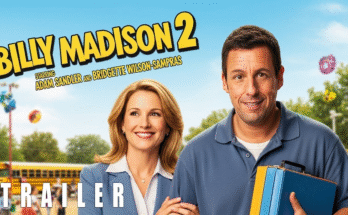Some houses heal. Others remember. Poltergeist II: The Returned resurrects one of horror’s most iconic myths with chilling precision, blending the spectral dread of the 1980s original with Mike Flanagan’s signature emotional depth. The result is a haunting that’s not just terrifying — it’s profoundly human, exploring how grief, guilt, and faith echo across generations like whispers through static.

The story begins forty years after the Freelings fled Cuesta Verde. The suburban paradise has been rebuilt, sanitized, and forgotten — at least on the surface. When renowned paranormal investigator Dr. Elise Harrow (Vera Farmiga) and her husband, theologian Dr. Nathan Harrow (Patrick Wilson), move into the newly redeveloped neighborhood to research residual energy fields, their intentions are purely academic. But Cuesta Verde has been waiting.
From the moment they arrive, the air feels charged — TVs flicker on without power, the walls hum with frequency, and the wind seems to carry voices that speak only in past tense. The Harrows’ teenage daughter Lucy (Millie Bobby Brown) becomes especially drawn to an old, unfinished foundation on the outskirts of the property. One night, she hears it — a soft, childlike voice from beneath the earth whispering: “Come into the light.”

That’s when the hauntings begin.
Flanagan’s direction is meticulous and hypnotic, turning ordinary spaces into liminal traps. He shoots with long, lingering takes that seem to breathe — mirrors distort faces, static becomes symphonic, and every silence feels like something listening. It’s not about jump scares, but dread that crawls under the skin and stays there.
Vera Farmiga delivers a powerhouse performance as Dr. Harrow — intelligent, composed, but slowly fraying under the weight of the unseen. Her arc mirrors that of the original’s Diane Freeling: a mother fighting not only supernatural forces, but the slow collapse of her family’s sanity. Her chemistry with Patrick Wilson adds emotional gravity, as the couple’s shared faith and scientific skepticism unravel in parallel. Their debates — theology versus energy, belief versus proof — become a haunting rhythm of their own.

Millie Bobby Brown is the film’s emotional center. Her Lucy isn’t a victim, but a vessel — a conduit for the voices trapped between worlds. Her portrayal oscillates between innocence and possession with eerie authenticity. One sequence — where Lucy sits motionless before a static-filled television, her reflection moving independently — is pure Flanagan nightmare fuel.
Finn Wolfhard plays Owen, a skeptical neighbor’s son drawn into the Harrows’ investigation. His presence injects tension and youth, balancing the film’s emotional weight with curiosity and rebellion. When he and Lucy uncover a buried section of the old Freeling home beneath the earth, the audience realizes — Cuesta Verde was never rebuilt; it was buried alive.
Flanagan’s horror thrives in its humanity. The haunting isn’t random — it’s inherited. The spirits that once haunted Carol Anne now cling to her bloodline, desperate for release. The film weaves this generational curse through archival recordings, flickering projectors, and distorted memories. The entity that once declared “They’re here” now whispers, “We never left.”

The visual design is stunning — spectral light cascading through fog, the television glow rendered like an altar. Flanagan’s frequent cinematographer, Michael Fimognari, uses cold blues and flickering golds to create a palette that feels both sacred and decayed. The ghosts, when they appear, are not monsters but echoes — shimmering silhouettes that seem to dissolve in sorrow.
Composer The Newton Brothers return with an ethereal score that blends children’s lullabies, reversed choral motifs, and analog feedback. It’s unsettling yet mournful, capturing the essence of lost souls who only want to be remembered.
The final act is both terrifying and transcendent. Beneath Cuesta Verde’s foundations lies a spectral void — a mass grave of energy and anguish. The Harrows descend into the underground cavern to sever the connection once and for all. What they find is not a monster, but memory itself: a glowing vortex of faces, laughter, screams — the afterimage of every life the poltergeist consumed.
Flanagan ends not with a scream, but with silence. Lucy, now free but forever changed, stands before the resurrected television as dawn breaks. The static fades… but just before it goes black, a faint voice whispers one last time: “Stay with us.”
💬 Film Verdict:
⭐ 9.1/10 — Visceral, poetic, and deeply unsettling. “Poltergeist II: The Returned” turns terror into tragedy, and the supernatural into something heartbreakingly human. The house isn’t haunted — the family is. 💀✨




